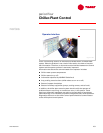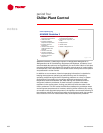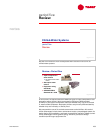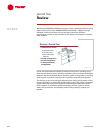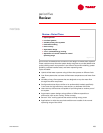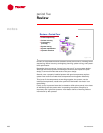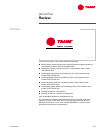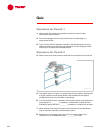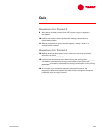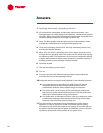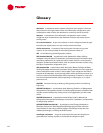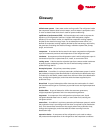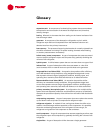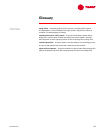
TRG-TRC016-EN 113
Glossary
chilled-water system Uses water as the cooling media. The refrigerant inside
the evaporator absorbs heat from the water, and this water is pumped to coils
in order to absorb heat from the air used for space conditioning.
coefficient of performance (COP) A dimensionless ratio used to express the
efficiency of a refrigeration machine. A higher COP designates a higher
efficiency. For an electric chiller, it is defined as evaporator cooling capacity
divided by the electrical energy input. For an absorption water chiller, it is
defined as evaporator cooling capacity divided by the heat energy required by
the generator, excluding the electrical energy needed to operate the pumps,
purge, and controls.
compressor A mechanical device used in the vapor-compression refrigeration
cycle to increase the pressure and temperature of the refrigerant vapor.
condenser A component of the refrigeration cycle in which refrigerant vapor is
converted to liquid as it rejects heat to air, water, or some other fluid.
cooling tower A device used to reject the heat from a water-cooled condenser
by spraying the condensing water over the fill while drawing outdoor air
upward through the fill.
decoupled system See primary-secondary system.
deficit flow A condition in a primary-secondary chilled-water system in which
the production loop provides less flow than is required by the distribution loop.
To make up for this deficit, water travels from the return side of the distribution
loop, through the bypass pipe, and mixes with the water supplied by the
production loop.
direct-fired A type of absorption chiller that uses the combustion of a fossil
fuel (such as natural gas or oil) directly to provide heat to the high-temperature
generator.
double-effect A type of absorption chiller that uses two generators,
a high-temperature generator and a low-temperature generator.
evaporator A component of the refrigeration cycle where cool, liquid
refrigerant absorbs heat from air, water, or some other fluid, causing the
refrigerant to boil.
excess flow A condition in a primary-secondary chilled-water system in which
the production loop is providing more flow than is required by the distribution
loop. This excess water travels from the supply side of the production loop,
through the bypass pipe, and mixes with the water returning from the
distribution loop.
expansion device A component of the refrigeration cycle used to reduce
the pressure and temperature of the refrigerant to the evaporator conditions.



